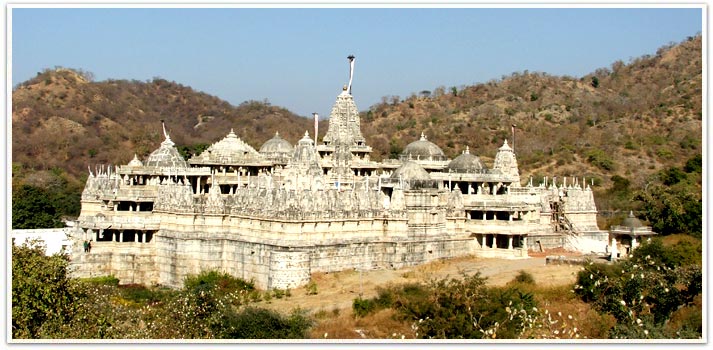Among Rajasthan’s most famous tourist hot spots is Ranakpur. Located in a valley on the western side of the Aravalli range, the closest railway station to reach Ranakpur is the Falna railway station. One can also drive to Ranakpur through the 90 km stretch from Udaipur.
Ranakpur is known as the grand temple town of Rajasthan. It’s marble Jain temple is amongst India’s finest Jain pilgrimages. The Udaipur royal family trust manages the local Sun temple, another tourist attraction here.
The Jain temple is “chaumukha” (i.e. it has four faces and four entrances, representing Tirthankara’s victory over the four cardinal directions – and therefore the universe). The temple is a dedication to Adinatha, the founder of Jainism. The temple’s architecture and stonework is inspired by the Rajasthan’s Mirpur Jain temple.
A copper-plate inscription, placed in the temple, records its construction. According to the inscription, Dharanashah, a Porwal, dreamt of the Nalinigulma Viman, the most beautiful of the celestial vehicles. This inspired him to construct this temple. While many sculptors attempted to recreate Dharanashah’s vision, only one, named Deepaka, could achieve this.
It was funded by Rana Kumbha, Mewar’s erstwhile liberal monarch ruler, and built in the 15th century after 50 years of construction. While Rana Kumbha was only asked for land for the temple, the king also advised Dharanashah to set up a township nearby on the old Madgi village. That town is today known as Ranakpur.
The temple has seen many renovations. The Anandji Kalyanji Pedhi trust has managed the temple for over a hundred years, and many Jain families have financed the devakulika and the mandap construction.
The winter months are best suited for sightseeing. The summers are obviously out of question, and even the monsoons see heat and humidity due to scanty rains.
The temples reveal the architectural finesse of Rajasthani craftsmen during this era. The Temple’s light colored marble construction covers an area of about 60 x 62 meters. The local topography is incorporated into the temple design – from a distance, you can see that the domes, shikhara and turrets rise from a hill’s slope.
The massive temple covers an area of over 48,000 sq. feet area, and features 3 three small shrines, 24 pillared halls, and domes. The entire temple is supported by ornately carved marble pillars. It is said that no two pillars look the same due to their distinctive carving, and that every temple statue faces another statue.
Interestingly, while there are pillars that can be seen from every direction, none obstructs the view of the Lord’s image. The temple has a single marble rock with 108 snakes, and this faces all four directions. Balconies (mandapas) are placed at strategic intervals to enable the pilgrims to rest. The Garbha Graha (Sanctum Sanctorum) features 4 massive marble images of Bhagvan Adinath, which all face different directions.
The second and third storey’s sanctuaries also feature four identical Jain images. Other names for the temple include ‘Dharan Vihar’ (named after the minister Dharanashah), Trailokya Deepak Prasad, and Tribhuvan Vihar (The light of the three lokas).

